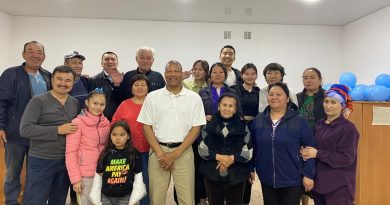History walk to complete first phase
The first phase of Hebron’s Walking History Trail holds 16 sites, starting at Roosevelt Park to cover four stories — Fort Butler, the original survey of Hebron, the city’s founding families and the history of the park.
“We are attempting to tell the history of Hebron with historic buildings,” Karla Joe, who is on the History Trail committee, said.
The committee, Joe, David Cording, Linda McLaughlin Simonsen and Lori Baldwin Werner, have been working on the trail for more than a year. In February of 2022, the committee had completed a few interviews with some of Hebron’s older residents, along with naming important points on the trail, like the historic Thayer County Courthouse and three locations related to the Suffrage movement.
Joe also approached the county commissioners about easements for the signs identifying historical locations. All easements have been received and filed and sign posts are also ready.
Joe said the committee made every attempt to have the signs and posts made locally.
“Every sign will have a QR code, where you can listen to the story of the location you’re looking at and it’s all done by local students,” Joe said at this year’s Independence Day celebration.
For example, she said, those on the trail can listen to Hometown Intern Chloe Hintz tell the story of Roosevelt Park.
People don’t necessarily have to walk the trail to hear the history — they can also listen on their home computers via the city’s website.
“Ideally, we’re encouraging people to walk and learn about the history,” Joe said.
Buildings included on the first phase of the trail are Masonic Hall (now the Blue Bison); Hebron Secrest Library, Hebron Presbyterian Church and the Majestic Theatre, Hebron’s former Opera House.
Another downtown building at 341 Lincoln Ave., the C.C. Fletcher three-story structure with a basement built in 1893. The narrative tells of “striking features, large bay windows, cupolas, ornate brick and tin work, and decorative iron posts shipped from St. Louis, Mo.”
The first business in the building was Boston Clothing Store until 1929. Later, the upstairs was utilized by the Hebron Legion Club. A mural painted upstairs by Art Werner depicted the mill and dam on the Little Blue River.
The second phase of the trail will begin on South 4th Street near Willard Avenue with the Chautauqua Area, Hebron Academy and the Dean’s House, and Willard Park. The trail continues to Riverside Park and the American Legion ball field for the Civilian Conservation Corps Camp and Prisoner of War Camp. Additional locations on the second phase of the trail are businesses on Lincoln Avenue and the Train Turn-Style and Depot. The 1953 tornado is also planned for phase two.
The ongoing project has opened paths of research for the committee, which strives to present information as accurately as possible.
And, it has surprised committee members, like Cording.
“For instance, no one at the theater they put a pipe organ in the Majestic in 1926,” Cording said. The organ was for silent movies. “Everything we learn opens up another avenue of research for us and I’ll be researching the pipe organ that was in the Majestic.”


